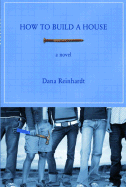
 Seventeen-year-old Harper Evans, who narrates this moving novel, worries that we are "ruining the planet." She thinks about this as she watches the landscape change through her window on an airplane that carries her from her native Los Angeles to Bailey, Tenn., where a tornado has demolished an entire town and where she will build a house for a family left homeless by the catastrophe. Reinhardt (A Brief Chapter in My Impossible Life) smoothly moves between the outer events Harper observes and her attempts to make sense of the personal challenges she faces ("I know a thing or two about people whose homes have been destroyed"). Gradually we learn that Harper's mother died when she was two, that her father married Jane, a woman who became a loving parent to her at age six, and that Harper also gained a sister and best friend, Tess, in this newfound family. But now Jane and her father are separated, driving a wedge between Harper and Tess. In her confusion, Harper turns to Gabriel, her closest male friend, and their friendship crosses into a sexual-platonic gray area that they never discuss. These flashbacks are triggered by moments in the here and now, as Harper and four others from the Homes from the Heart Summer Program for Teens build a foundation for the house, erect walls, paint them and shingle the roof. And there's one other teen, Teddy Wright. They are building this house for him, for his parents and his twin nine-year-old sisters, who have come to the aid of every other family that stayed in Bailey. The structure of the novel (organized into the major steps involved in erecting a house) at times feels constricting, but the story of Harper's evolution throughout one pivotal summer is fluid and well developed. The author effortlessly integrates Harper's sense of wonder about the earth at key moments; in the leadup to her first romantic encounter with Teddy at dusk on the Fourth of July, for instance, she notices, "At the edges, the sky is the color of a kitten's tongue." The heroine's growing trust in Teddy draws a striking contrast between the somewhat random physical contact she experienced with Gabriel versus sex with Teddy as a mindful expression of companionship and trust. Reinhardt raises provocative questions about the nature of commitment between human beings and the earth--and one another.--Jennifer M. Brown
Seventeen-year-old Harper Evans, who narrates this moving novel, worries that we are "ruining the planet." She thinks about this as she watches the landscape change through her window on an airplane that carries her from her native Los Angeles to Bailey, Tenn., where a tornado has demolished an entire town and where she will build a house for a family left homeless by the catastrophe. Reinhardt (A Brief Chapter in My Impossible Life) smoothly moves between the outer events Harper observes and her attempts to make sense of the personal challenges she faces ("I know a thing or two about people whose homes have been destroyed"). Gradually we learn that Harper's mother died when she was two, that her father married Jane, a woman who became a loving parent to her at age six, and that Harper also gained a sister and best friend, Tess, in this newfound family. But now Jane and her father are separated, driving a wedge between Harper and Tess. In her confusion, Harper turns to Gabriel, her closest male friend, and their friendship crosses into a sexual-platonic gray area that they never discuss. These flashbacks are triggered by moments in the here and now, as Harper and four others from the Homes from the Heart Summer Program for Teens build a foundation for the house, erect walls, paint them and shingle the roof. And there's one other teen, Teddy Wright. They are building this house for him, for his parents and his twin nine-year-old sisters, who have come to the aid of every other family that stayed in Bailey. The structure of the novel (organized into the major steps involved in erecting a house) at times feels constricting, but the story of Harper's evolution throughout one pivotal summer is fluid and well developed. The author effortlessly integrates Harper's sense of wonder about the earth at key moments; in the leadup to her first romantic encounter with Teddy at dusk on the Fourth of July, for instance, she notices, "At the edges, the sky is the color of a kitten's tongue." The heroine's growing trust in Teddy draws a striking contrast between the somewhat random physical contact she experienced with Gabriel versus sex with Teddy as a mindful expression of companionship and trust. Reinhardt raises provocative questions about the nature of commitment between human beings and the earth--and one another.--Jennifer M. Brown



